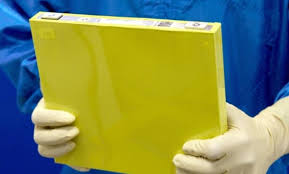
Breaking News
 GM's LMR battery breakthrough means more range at a lower cost
GM's LMR battery breakthrough means more range at a lower cost
 CPI Better than Expected Thanks to a Drop in the Price of Food
CPI Better than Expected Thanks to a Drop in the Price of Food
Top Tech News
 Cab-less truck glider leaps autonomously between road and rail
Cab-less truck glider leaps autonomously between road and rail
 Can Tesla DOJO Chips Pass Nvidia GPUs?
Can Tesla DOJO Chips Pass Nvidia GPUs?
 Iron-fortified lumber could be a greener alternative to steel beams
Iron-fortified lumber could be a greener alternative to steel beams
 One man, 856 venom hits, and the path to a universal snakebite cure
One man, 856 venom hits, and the path to a universal snakebite cure
 Dr. McCullough reveals cancer-fighting drug Big Pharma hopes you never hear about…
Dr. McCullough reveals cancer-fighting drug Big Pharma hopes you never hear about…
 EXCLUSIVE: Raytheon Whistleblower Who Exposed The Neutrino Earthquake Weapon In Antarctica...
EXCLUSIVE: Raytheon Whistleblower Who Exposed The Neutrino Earthquake Weapon In Antarctica...
 Doctors Say Injecting Gold Into Eyeballs Could Restore Lost Vision
Doctors Say Injecting Gold Into Eyeballs Could Restore Lost Vision
 Dark Matter: An 86-lb, 800-hp EV motor by Koenigsegg
Dark Matter: An 86-lb, 800-hp EV motor by Koenigsegg
 Spacetop puts a massive multi-window workspace in front of your eyes
Spacetop puts a massive multi-window workspace in front of your eyes
GM's LMR battery breakthrough means more range at a lower cost

WARREN, Mich.—If you've been following General Motors' development of electric vehicles on its Ultium platform, you'd be forgiven for thinking that it hasn't gone entirely smoothly. While plagued by some initial hiccups, GM has worked through those issues and now has a total of 12 EVs on the road. By my count, that's nine more than Ford, the crosstown rival that had a significant lead in this generation of EVs.
Furthering GM's advancement is the development of new battery technologies. Kurt Kelty, the company's newest head of batteries (after spending 12 years at Tesla), told me that new technology is a way to get to mass adoption of EVs.
"There needs to be price parity between gasoline and electric," he told me. "Without the tax credit."
Right now, Kelty says the price differential between the two is around $7,500, which non-coincidentally is the amount of the current federal tax incentive. That's why new—and cheaper—technologies are important and the reason I went to GM's Warren Technical Center, where the company provided a sneak peek at its LMR battery technology.
"Our goal is to reduce cost," Kelty said. The company expects LMR to do just that.
LFP price + NCM range = LMR?
So what is LMR? Lithium manganese-rich is a lithium-ion technology designed to remove a significant amount of cobalt from the cathode, which reduces the cost of the battery to near LFP (lithium iron phosphate) levels, while maintaining more energy density.
"We expect to have near-NMC [nickel manganese cobalt] range for the price of an LFP battery," said Andy Oury from the company's battery team. While the company wouldn't talk about price numbers—the technology is set to appear in trucks in 2028—it said the range will be about 30 percent greater than today's maximum-range LFP packs.
GM will use prismatic cells for its LMR tech, and the packs will reduce in complexity from the setup in its current electric trucks. "We're reducing the number of cells to six, down from 24," Oury said. These new cells will live in the space currently occupied and exist alongside LFP and NMC batteries both in the showroom and on the assembly line.
So why not just use one big cell instead of the six separate prismatic ones?
Some automakers do that, but I was told the bifurcation of the pack is important to GM because the pack is a structural element of the vehicle. So while you can reduce some of the complexity, some needs to remain.
Removing the cobalt also reduces weight. Considering that the battery in the Hummer EV weighs as much as a Honda Civic, any weight savings is appreciated.
On a truck like the Silverado EV, NMC batteries would still be offered to those who want the most range, 400 miles (643 km) or more. The LMR will be offered as an in-between at around 350 miles (536 km), with LFP as the entry-level offering.
GM wouldn't elaborate when I asked why LMR couldn't be the base chemistry across the entire fleet since more range for the same price as LFP seems like the holy grail of battery tech. The company said it has its reasons for why the tech is appearing in the trucks but not in a crossover like the Equinox EV or the upcoming Chevrolet Bolt.

 What Steak Thickness is Best?
What Steak Thickness is Best?
 Coke Train: Why It Matters!
Coke Train: Why It Matters!
 Node without Consent
Node without Consent

